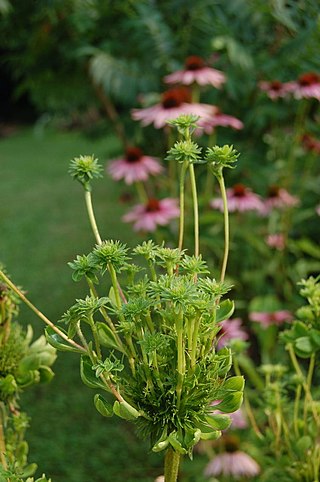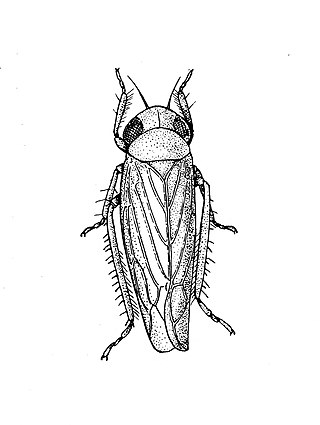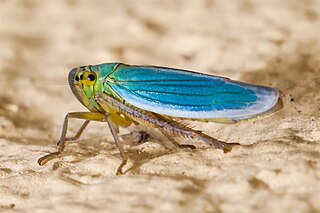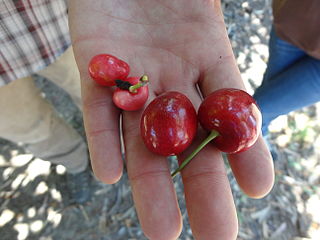
Hemiptera is an order of insects, commonly called true bugs, comprising over 80,000 species within groups such as the cicadas, aphids, planthoppers, leafhoppers, assassin bugs, bed bugs, and shield bugs. They range in size from 1 mm (0.04 in) to around 15 cm (6 in), and share a common arrangement of piercing-sucking mouthparts. The name "true bugs" is often limited to the suborder Heteroptera.

Phytoplasmas are obligate intracellular parasites of plant phloem tissue and of the insect vectors that are involved in their plant-to-plant transmission. Phytoplasmas were discovered in 1967 by Japanese scientists who termed them mycoplasma-like organisms. Since their discovery, phytoplasmas have resisted all attempts at in vitro culture in any cell-free medium; routine cultivation in an artificial medium thus remains a major challenge. Phytoplasmas are characterized by the lack of a cell wall, a pleiomorphic or filamentous shape, a diameter normally less than 1 μm, and a very small genome.

The glassy-winged sharpshooter is a large leafhopper, similar to other species of sharpshooter.

A leafhopper is the common name for any species from the family Cicadellidae. These minute insects, colloquially known as hoppers, are plant feeders that suck plant sap from grass, shrubs, or trees. Their hind legs are modified for jumping, and are covered with hairs that facilitate the spreading of a secretion over their bodies that acts as a water repellent and carrier of pheromones. They undergo a partial metamorphosis, and have various host associations, varying from very generalized to very specific. Some species have a cosmopolitan distribution, or occur throughout the temperate and tropical regions. Some are pests or vectors of plant viruses and phytoplasmas. The family is distributed all over the world, and constitutes the second-largest hemipteran family, with at least 20,000 described species.

Xylella fastidiosa is an aerobic, Gram-negative bacterium of the genus Xylella. It is a plant pathogen, that grows in the water transport tissues of plants' and is transmitted exclusively by xylem sap-feeding insects such as sharpshooters and spittlebugs. Many plant diseases are due to infections of X. fastidiosa, including bacterial leaf scorch, oleander leaf scorch, coffee leaf scorch (CLS), alfalfa dwarf, phony peach disease, and the economically important Pierce's disease of grapes (PD), olive quick decline syndrome (OQDS), and citrus variegated chlorosis (CVC). While the largest outbreaks of X. fastidiosa–related diseases have occurred in the Americas and Europe, this pathogen has also been found in Taiwan, Israel, and a few other countries worldwide.

Curly top is a viral disease that affects many crops. This disease causes plants to become smaller in size, have shriveled petals and leaves, and are twisted and pulled out of shape. They are often caused by curtoviruses, members of the virus family Geminiviridae. This disease is important in western United States, such as California, Utah, Washington, and Idaho.

The beet leafhopper, also sometimes known as Neoaliturus tenellus, is a species of leafhopper which belongs to the family Cicadellidae in the order Hemiptera.

Beet curly top virus (BCTV) is a pathogenic plant virus of the family Geminiviridae, containing a single-stranded DNA. The family Geminiviridae consists of nine genera based on their host range, virus genome structure, and type of insect vector. BCTV is a Curtovirus affecting hundreds of plants. The only known vector is the beet leafhopper, which is native to the Western United States.

Flavescence dorée is one of the most important and damaging phytoplasma diseases of the vine with the potential to threaten vineyards. The bacterial agent has recently been named Candidatus Phytoplasma vitis, and its vector is the leafhopper, Scaphoideus titanus. Infection may kill young vines and greatly reduce the productivity of old vines. It is classified as a phytoplasma disease belonging to the group generically termed grapevine yellows. Occurrences are in sporadic epidemics, and varieties vary in their sensitivity to it.

Graphocephala coccinea is a meadow and woodland-dwelling species of brightly colored leafhopper native to North and Central America, from Canada south to Panama. Common names include candy-striped leafhopper, red-banded leafhopper, scarlet-and-green leafhopper and red-and-blue leafhopper.

Celery mosaic virus (CeMV) is a plant pathogenic virus in the genus Potyvirus and the virus family Potyviridae .

Aphrophora alni, the European alder spittle bug, is a species belonging to the family Aphrophoridae.

Cicadella viridis, the green leafhopper, is a species belonging to the subfamily Cicadellinae of the family Cicadellidae.

Centrotus cornutus (thorn-hopper) is a species of "treehoppers" belonging to the family Membracidae.
The Citrus stubborn disease is a plant disease affecting species in the genus Citrus. Spiroplasma citri, a Mollicute bacterium species, is the causative agent of the disease. It is present in the phloem of the affected plant. Originally discovered transmitted by several leafhoppers including Circulifer tenellus and Scaphytopius nitridus in citrus-growing regions of California, it is now spread by the same hoppers in Arizona and Circulifer haematoceps in the Mediterranean region.

Cherry X disease also known as Cherry Buckskin disease is caused by a plant pathogenic phytoplasma. Phytoplasmas are obligate parasites of plants and insects. They are specialized bacteria, characterized by their lack of a cell wall, often transmitted through insects, and are responsible for large losses in crops, fruit trees, and ornamentals. The phytoplasma causing Cherry X disease has a fairly limited host range mostly of stone fruit trees. Hosts of the pathogen include sweet cherry, sour cherry, choke cherry, peaches, nectarines, almonds, clover, and dandelion. Most commonly the pathogen is introduced into economical fruit orchards from wild choke cherry and herbaceous weed hosts. The pathogen is vectored by mountain and cherry leafhoppers. The mountain leafhopper vectors the pathogen from wild hosts to cherry orchards but does not feed on the other hosts. The cherry leafhopper feeds on cherry trees and can transmit the disease from cherry orchards to peach, nectarine, and other economic crops. Control of Cherry X disease is limited to controlling the spread, vectors, and weed hosts of the pathogen. Once the pathogen has infected a tree it is fatal and removal is necessary to stop it from becoming a reservoir for vectors.

Oncopsis flavicollis is a species of leafhoppers belonging to the family Cicadellidae subfamily Eurymelinae.

Japananus hyalinus, the Japanese maple leafhopper, is a species of leafhopper of the subfamily Deltocephalinae and tribe Opsiini. Believed to be native to eastern Asia, it has been carried with the trade in cultivated maples and is now widely found in Europe, North America and Australia.

Erasmoneura vulnerata is a species of leafhopper native to North America. The species was found to be in Europe in 2004 where it causes significant economic damage to grapevine yards. E. vulnerata is commonly found on wild and cultivated grapes from both continents. Its Latin name translates to "wounded Erasmoneura" from its original description.



















